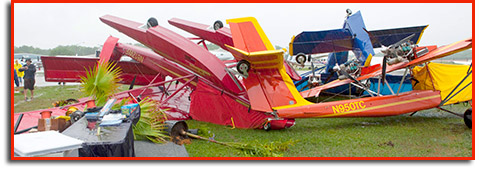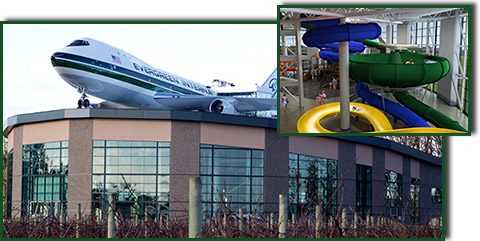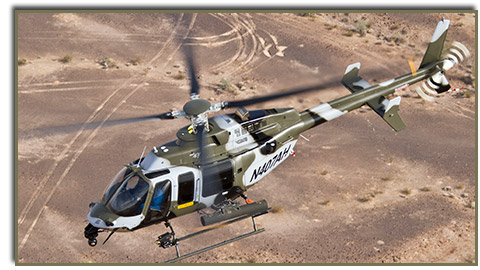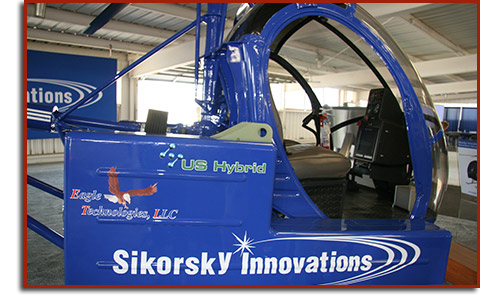Pilot Briefing
Little town, big terminal
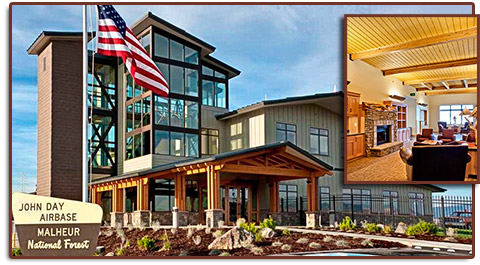
What sort of airport terminal would you expect a city of 2,000 to have? Would it even be called a “terminal”?
It would be tiny—1,100 square feet, to be exact—and would be called an FBO. The airport manager would have a closet-sized office. Heat would circulate so poorly in winter that it would be the same as having no heat. Same for air conditioning in summer. That’s what Grant County Regional/Ogilvie Field in the town of John Day, Oregon, had.
It was the office of Airport Manager Colin English. Now look at what he has. His office is on the second floor of a new, well-heated and well air-conditioned $4.2 million palace with a beautiful view. A pilot lounge can be accessed anytime, even when the main building is closed. It has restrooms, showers, satellite TV, Internet, and a bunk room with two beds. The building is heated by an innovative biomass heating plant costing only $300,000 and burning wood pellets left over from logging operations, saving $30,000 a year over conventional heating methods.
The Oregon State University Extension office conducts evening classes there each month. County departments and the U.S. Forest Service meet there. Anniversary and baby showers are celebrated there, and recently a man came in with his daughter to consider the terminal for her wedding and reception. Pilots land there just to look.
“I have yet to see any other kind of rural airport like this. It is unique. I have seen regional and medium-sized airports that don’t have anything like this,” English said.
The recently renovated main runway is 5,220 feet long. The crosswind runway is 4,500 feet.
“Quite a bit of transient pilots flying Spokane to Sacramento and Boise to Portland stop here,” English said. “We’re meeting next week on getting a sandwich and coffee shop during the summer.” The airport has excellent snow- removal capability and the terminal has only been closed one day since opening in September 2010. That was a December day when snow was coming down at three to four inches an hour.
There is no airline service. You still need to drive 3.5 hours to Redmond, Oregon, to catch a regional flight. Boise, Idaho, and Bend, Oregon, are also 3.5 hours away by car. So what is the secret to getting the sort of terminal this little community built?
The U.S. Forest Service is a partner in the building and contributed an $800,000 matching grant, while Oregon contributed millions. The FAA contributed comparatively little.
The partnership with the Forest Service is the first time such an agreement has been used, and now the agency is using John Day as a model for the
nation. It hopes to partner with other communities and states to share costs for the benefit of itself and the local community. The airport has 8,000 square feet of the building, while the Forest Service has 19,500 square feet. Each time there is a Chamber of Commerce or other local group using the terminal for meetings, it is another $30 to $50 for the airport in rental fees. “It’s a new revenue stream,” English said. Meetings started immediately last September and are increasing steadily. There were 14 revenue-producing meetings in March.
“The main response from people who walk in is, their jaw drops, and they say, ‘Wow, I did not expect this,’” English said.
Storm damage
 The tornado that struck the Sun ’n Fun Fly-In on March 31 was both furious and fickle. It ripped airplanes from secure tiedowns and sent them careening across the ramp, scattered tree limbs and tents across Lakeland Linder Regional Airport, and overturned aircraft as large as a Cessna Caravan. At the same time, however, it often left others—including fragile light sport aircraft—completely unscathed.
The tornado that struck the Sun ’n Fun Fly-In on March 31 was both furious and fickle. It ripped airplanes from secure tiedowns and sent them careening across the ramp, scattered tree limbs and tents across Lakeland Linder Regional Airport, and overturned aircraft as large as a Cessna Caravan. At the same time, however, it often left others—including fragile light sport aircraft—completely unscathed.
“I had a lot of love in that airplane, and my 14-year-old son helped me build it,” sad Tad “Stripes” Sargent, whose Vans RV–7A was demolished in the storm. “But it’s only an airplane, and I’m so glad that no one was seriously hurt. I can build another airplane.”
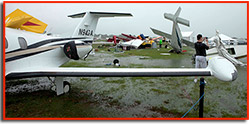 Sargent, a member of Team RV, a formation flying team that had been scheduled to perform at the event, said three of the dozen airplanes group members flew to Sun ’n Fun and tied down together next to Runway 9/27 were destroyed while the others were mostly untouched.
Sargent, a member of Team RV, a formation flying team that had been scheduled to perform at the event, said three of the dozen airplanes group members flew to Sun ’n Fun and tied down together next to Runway 9/27 were destroyed while the others were mostly untouched.
Within 24 hours of the storm’s passage, remarkably resilient aviation industry representatives had largely rebuilt or replaced damaged displays. Volunteers and city crews removed debris and repaired the grounds, and the show opened the next day on time and under sunny skies. The U.S. Navy’s Blue Angels and others performed that weekend to some of the largest crowds in Sun ’n Fun history.
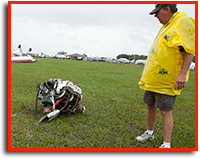 AOPA President Craig Fuller said the morning after the devastation that AOPA will return to Sun ’n Fun in 2012 as a platinum sponsor, and said the association’s support for the traditional first fly-in of the season is unwavering.
AOPA President Craig Fuller said the morning after the devastation that AOPA will return to Sun ’n Fun in 2012 as a platinum sponsor, and said the association’s support for the traditional first fly-in of the season is unwavering.
Sun ’n Fun President John Burton thanked AOPA for the “strong show of support” and said he and the organization he leads “appreciate it more than you can ever know.”
For personal reflections on the storms, see “ President’s Position,” and “ Waypoints.” —Dave Hirschman
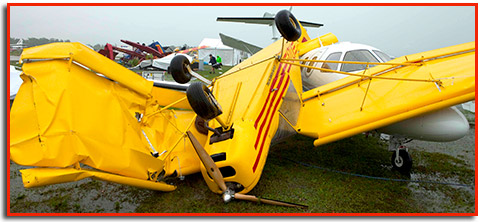
Kids slide into aviation from a Boeing 747
Even adults will enjoy a kids’ water slide planned to open June 6 at the Evergreen Aviation and Science Museum in McMinnville, Oregon. The Evergreen Wings and Waves Waterpark offers four slippery routes, from tame to wild and crazy, and all of them start from inside a retired Evergreen Boeing 747 mounted on top of a 60-foot-tall building.
The museum may be better known to some as the new home of the Howard Hughes Spruce Goose, already on display.
The waterpark is part of the museum’s Captain Michael King Smith Educational Institute, dedicated to the late son of Evergreen Aviation founder Delford M. Smith, now the chairman of the board of the museum. In the waterpark, there will be a 10,000-square-foot children’s museum with nearly two dozen interactive exhibits designed to teach concepts like propulsion, Bernoulli’s principle, the water cycle, and harnessing water as power. The aim is to teach not only about the science of water, but also about the basic principles of aviation and space flight, incorporating the aviation, space, and water themes already present in the main museum.
Visitors climb to the airplane and choose the slide of their choice. The “Nose Dive” is a high-energy, two-person inner-tube ride that combines a fast initial drop during a high-bank turn through a dark “oscillation” section before “breaking out of the clouds” into a circular bowl below. The ride culminates in a smooth splash landing.
The “Signature” ride starts with a steep run into the bowl itself followed by a rotational routing around the bowl. The “Mach One” slide is high-speed ride that shoots visitors through a transparent orange tube above the entry to the park. The “Tail Spin” is high energy and features fast acceleration and a tight series of figure-eight, high-bank curves. The “Sonic Boom” is the mildest of the rides, although its name may not sound tame.
The 747 now at rest flew 58.5 million miles before gracing the top of the waterpark. It took two cranes to lift the aircraft to the top of the building, with one used to prevent oscillations. The maneuver required one of only seven aircraft slings available in the world to lift the aircraft. Engines were removed, but the aircraft still weighed 328,000 pounds. There are 28,000 pounds of ballast in the nose. The aircraft acts like a big sail atop the building, requiring rugged superstructure below to handle wind forces.
Waterpark officials claim it is the first time a Boeing 747 has ever been placed atop a building anywhere in the world. —Dan Namowitz
Say Again?
Aerodynamics
- What was aerodynamicist Richard Whitcomb’s biggest contribution to high-speed flight?
- “Supercruise” is the ability of an aircraft, such as the F–22 Raptor, to fly at supersonic speed without the use of gas-guzzling afterburners. What was the world’s first aircraft to accomplish this feat?
- What aerodynamic feature do the MiG–15, F–86, and Boeing 707 have in common?
- The Bell X–1 showed the advantages of non-hinged control surfaces for supersonic and transonic flight. What was the last U.S. fighter built with hinged control surfaces?
- What high-flying U.S. pilot discovered the jet stream (but never flew a jet)?
Civilian gunship shown at helicopter convention
Want your personal helicopter armed? Bell Helicopter is developing an armed commercial helicopter based on its 407 model. It is aimed at a wide range of law enforcement and paramilitary missions worldwide.
The 407AH (attack helicopter) can be customized for multiple weapon systems. “This is another example of Bell Helicopter responding directly to customer needs,” said Larry Roberts, senior vice president for commercial business. “The 407 is a high-performance platform with exceptional maneuverability, speed, payload, and range. It will meet the needs of a variety of para-public agencies at a cost that is far less than that of a similarly equipped military aircraft—but with increased lethality.”
The helicopter’s initial weapon system includes a Dillon 7.62 M134T Minigun as well as a seven-shot rocket launching system, using 2.75-inch rockets. Optional equipment includes a chaff and flares system for countermeasures, sliding doors in the rear for cargo or personnel transportation, a cargo hook for search and rescue capability, and crew seat armor in case the bad guy shoots back.
Robinson Helicopter sales recovering
Robinson Helicopter President Kurt Robinson and his father, company founder Frank Robinson, think the worst is behind them as far as the economy is concerned. After delivering only 162 rotorcraft in 2010, there is now a backlog of 169 new orders.
Total production last year was 40 R22 models, 112 R44 models, and 10 R66 turbine helicopters. The company had to work its way through an unsold inventory before logging new orders. The new problem is to increase production. Robinson currently builds seven helicopters a week, including two five-place R66 helicopters, four R44 four-place models, and one R22 two-place model.
The company must also introduce the R66 on floats, a model with a cargo hook, an IFR trainer model, an R66 for police work, and another designed for news work. The news helicopter will be the last to be developed. In the meantime, the company is pursuing certification of the R66 in a number of countries, including Canada, Brazil, and Russia. Kurt Robinson said the company is “not in a hurry” to certify glass-cockpit helicopter models. There are now 130 orders for the R66.
A new air conditioner weighing 42 pounds is now certified for the R66. The air conditioning option is $23,000.
Collings Foundation to fly Super Sabre
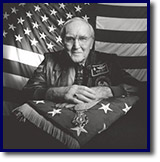 The Collings Foundation, a history preservation organization based in Stow, Massachusetts, will restore and fly a Vietnam-era North American F–100F Super Sabre jet. It will be painted to represent the jet used by Medal of Honor winner Bud Day (above), who fought in World War II, Korea, and Vietnam.
The Collings Foundation, a history preservation organization based in Stow, Massachusetts, will restore and fly a Vietnam-era North American F–100F Super Sabre jet. It will be painted to represent the jet used by Medal of Honor winner Bud Day (above), who fought in World War II, Korea, and Vietnam.
The jet had not yet been repainted. The Collings Foundation preserves history through its historic car and aircraft collections.
Day is considered to be one of the most decorated officers in the history of the U.S. Air Force. He survived a no-chute ejection from a Republic F–84 Thunderjet during his career. The engine caught fire on takeoff, and Day attempted a go-around, but had to eject. The chute did not open. He remained in his ejection seat as it crashed through trees and was badly injured.
He was shot down in Vietnam, severely wounded, and was captured and tortured. He escaped from his captors, almost making it to American camps in the demilitarized zone, but was captured again. He was taken to the infamous Hanoi Hilton prison where he was repeatedly tortured for more than five years. He was the first commander of the Misty Super FACs (forward air controllers) that operated F–100 jets. Day will be commemorated with an F–100F painted as his favorite Misty jet during the Vietnam War.
The F–100F Super Sabre joins the Collings Foundation’s Vietnam Memorial Flight that includes a McDonnell Douglas F–4 Phantom II, A–4 Skyhawk, and a UH–1E Huey helicopter.
Sikorsky wins Collier Trophy; other innovations in development
Sikorsky Aircraft has won the 2010 Robert J. Collier Trophy for its 250-knot X2 technology demonstrator. The award is to be presented at a National Aeronautic Association dinner May 5.
Technology breakthroughs in the helicopter industry can be huge because they change the history of rotor flight, or because they refer to really big flying machines. In the case of Sikorsky, both uses of the word apply. The twin-rotor helicopter, which can be ramped up in size, sped through 250 knots.
Say Again? Answers
- He defined the “area rule,” a discovery that influenced the Coke-bottle fuselage shape of many supersonic aircraft that followed. Whitcomb was awarded the Collier Trophy in 1954.
- The Concorde.
- The 35-degree wing sweep.
- The F–86 Sabre Jet (although later models incorporated non-hinged control surfaces).
- Wiley Post pioneered the pressure suit in 1934 and flew his Lockheed Vega, Winnie Mae, to altitudes up to 50,000 feet where he was the first to quantify sustained stratospheric winds well in excess of 100 miles per hour. (Jets hadn’t been invented at the time of Post’s discovery.)
Do you have suggestions for aviation quiz questions? Send your questions (and answers) to [email protected].
The X2 will first be a “Raider” military attack helicopter, and could be an emergency medical helicopter that carries patients a greater distance during the first “golden hour” after an injury. The S–97 Raider now in development will fly in four years as a 9,000- to 10,000-pound aircraft. The military model can fly at 210 to 230 knots indicated airspeed, fully armed. Its acoustics are 50 percent less than those of a conventional helicopter. It can turn in half the radius of a conventional helicopter. It can pull three Gs, carry a payload 40 percent greater than that of a conventional helicopter its size, and hover at an altitude that is 150 percent greater than helicopters of its class.
In a separate project, who says a helicopter needs a pilot? Sikorsky has flown a formation of two of its famous Black Hawk helicopters. The lead aircraft had a pilot; the one following closely in formation did not. Sikorsky helicopters have the ability to determine whether they are taking ground fire, and if so, from what direction. Both the piloted and unpiloted helicopters can then take evasive action. An unpiloted helicopter can return to being a piloted helicopter simply by throwing a switch.
But wait, there’s more. The design of the new CH–53K monster cargo helicopter is complete. Its main rotor hub weighs more than an entire Black Hawk helicopter, or 15,000 pounds. The tail rotor of the CH–53K has the same thrust as the main rotor of the company’s S–76 helicopter. The main rotor of the CH–53K has as much thrust as the main rotors of six Black Hawk helicopters. The helicopter weighs 88,000 pounds and carries 27,000 pounds of payload.
Sikorsky also has an electric helicopter with a 200-horsepower motor that can fly for 15 minutes, even though it must lift 1,100 pounds of batteries. “If we could get an hour, we could change the training industry,” Pino said.
Why all the research and development? Sikorsky has done relatively well during the recession, and has poured the money back into advanced technologies. It told a group of its engineers to stay 20 years in the future. It looks like they are succeeding.
